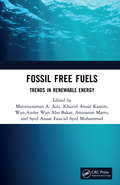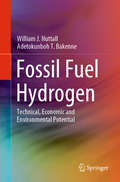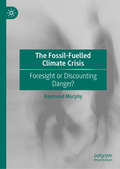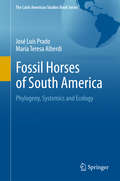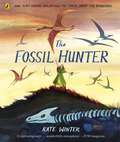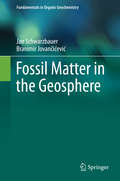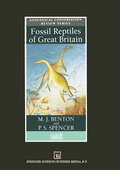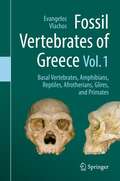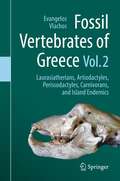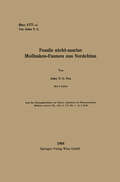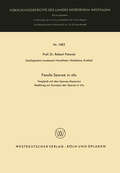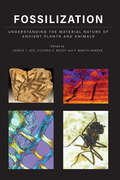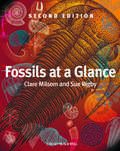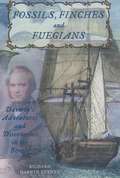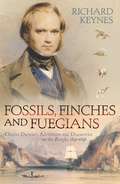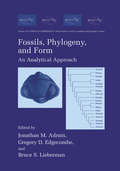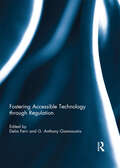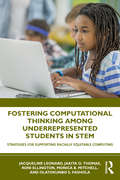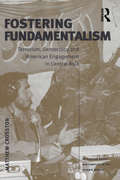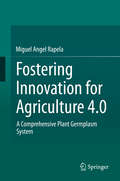- Table View
- List View
Fossil Free Fuels: Trends in Renewable Energy
by Maniruzzaman A. AzizMany approaches have been undertaken to mitigate global climate change, including the movement away from fossil fuels. Fossil Free Fuels: Trends in Renewable Energy examines several key topics, such as the utilization of biofuels as a sustainable renewable resource, recycling and untapped waste-to-energy products, and other carbon-neutral strategies in various industries, such as the transportation, construction, and manufacturing sectors. It provides recent updates on the latest technologies, modeling, design, and technical aspects, as well as several practical case studies. The current world energy scenario is examined and various solutions to larger environmental problems are outlined in terms of the shift to more alternative energy sources. Features: Minimizes technical jargon in a straightforward style for a wider audience Discusses sustainable options for different industries, such as the use of green materials in the construction sector, biofuels for transportation, and many more Includes numerous illustrations, tables, and figures to aid in understanding This book serves as a practical reference for engineers, researchers, environmental consultants working in renewable energy industries, and students.
Fossil Free Fuels: Trends in Renewable Energy
by Maniruzzaman Bin A. Aziz Khairul Anuar Kassim W. A. N. Azelee W. A. N. Abu Bakar Aminaton Marto Syed Anuar Faua Ad Syed MuhammadMany approaches have been undertaken to mitigate global climate change, including the movement away from fossil fuels. Fossil Free Fuels: Trends in Renewable Energy examines several key topics, such as the utilization of biofuels as a sustainable renewable resource, recycling and untapped waste-to-energy products, and other carbon-neutral strategies in various industries, such as the transportation, construction, and manufacturing sectors. It provides recent updates on the latest technologies, modeling, design, and technical aspects, as well as several practical case studies. The current world energy scenario is examined and various solutions to larger environmental problems are outlined in terms of the shift to more alternative energy sources. Features: Minimizes technical jargon in a straightforward style for a wider audience Discusses sustainable options for different industries, such as the use of green materials in the construction sector, biofuels for transportation, and many more Includes numerous illustrations, tables, and figures to aid in understanding This book serves as a practical reference for engineers, researchers, environmental consultants working in renewable energy industries, and students.
Fossil Fuel Hydrogen: Technical, Economic and Environmental Potential
by William J. Nuttall Adetokunboh T. BakenneAs the case for Climate Change mitigation becomes ever more pressing, hydrogen has the potential to play a major role in a low-carbon energy future. Hydrogen can drive the vehicles of tomorrow and also heat homes and supply energy to businesses. Much recent discussion in energy policy circles has considered ways in which greatly expanded electrification can meet the demand for low-carbon mobility and heating. Such narratives centre on the widespread use of renewable energy sources with occasionally surplus renewable electricity being used to produce hydrogen, for example by electrolysis. While such developments have a beneficial role to play, this book focuses on an alternative paradigm. This book considers a more evolutionary path involving the continued extraction and use of fossil fuels, most notably natural gas, but in ways that greatly reduce greenhouse gas emissions. In this way much established industrial capacity and know how might be transitioned to help deliver the low carbon future that the world so desperately requires. Presenting up-to-date energy policy recommendations with a focus on hydrogen from fossil fuels, the book will be of considerable interest to policymakers and energy researchers in academia, industry and government labs, while also offering a valuable reference guide for business developers in low-carbon energy, and for oil and gas industry analysts.
The Fossil-Fuelled Climate Crisis: Foresight or Discounting Danger?
by Raymond MurphyThis book analyses the threat posed by the continued use of fossil fuels. By utilizing Elizabeth Shove’s social practices approach and Murphy’s own social closure framework, the book examines the accelerating treadmill of carbon-polluting practices. It incorporates externalities theory to investigate how the full cost of fossil fuels is paid by others rather than users, and to demonstrate that the environmental commons is a medium for conveying intergenerational monopolisation and exclusion in the Anthropocene. Murphy uncovers a pattern of opposition to change when exploiting valuable but dangerous resources. He argues that a new faith in mastering nature is emerging as a belief in just-in-time technological solutions to circumvent having to change fossil-fuelled practices.The book then moves on to assess proposed solutions, including Beck’s staging of risk and his hypothesis that the anticipation of global catastrophe will incite emancipation. It proposes a novel approach to enhancing foresight and avoid incubating disaster. It will appeal to readers interested in an original social science analysis of this creeping crisis and its resolution.
Fossil Horses of South America: Phylogeny, Systemics and Ecology (The Latin American Studies Book Series)
by José Luis Prado María Teresa AlberdiThis book provides an update on the phylogeny, systematics and ecology of horses in South America based on data provided over the past three decades. The contemporary South American mammalian communities were shaped by the emergence of the Isthmus of Panama and by the profound climatic oscillations during the Pleistocene. Horses were a conspicuous group of immigrant mammals from North America that arrived in South America during the Pleistocene. This group is represented by 2 genera, Hippidion and Equus, which include small species (Hippidion devillei, H. saldiasi, E. andium and E. insulatus) and large forms (Equus neogeus and H. principale). Both groups arrived in South America via 2 different routes. One model designed to explain this migration indicates that the small forms used the Andes corridor, while larger horses used the eastern route and arrived through some coastal areas. Molecular dating (ancient DNA) suggests that the South American horses separated from the North American taxa (caballines and the New World stilt-legged horse) after 3.6 - 3.2 Ma, consistent with the final formation of the Panamanian Isthmus. Recent studies of stable isotopes in these horses indicate an extensive range of 13C values cover closed woodlands to C4 grasslands. This plasticity agrees with the hypothesis that generalist species and open biome specialist species from North America indicate a positive migration through South America.
The Fossil Hunter: How Mary Anning unearthed the truth about the dinosaurs
by Kate WinterUnearth the mysteries of ancient fossils and discover the life and legacy of Mary Anning in this beautifully illustrated, fact-filled book for curious young readers.Have you ever found something mysterious? Something where you had no idea what it was but you had this feeling it was important, that it held a secret?Mary Anning was a fossil hunter, scouring the cliffs and seashores of Lyme Regis for strange rocks and shells. Monstrous marine reptiles and dinosaurs had once reigned the land and seas here millions of years ago, disappearing only to leave mysterious traces for humans to puzzle over.Mary's fossils paved the way for modern palaeontology and helped to piece together a picture of how the dinosaurs lived and evolved. Little did she know that 200 years later we would still be talking about her amazing discoveries and how she influenced our understanding of the history of the earth.Beautifully illustrated by brand-new talent Kate Winter, with stunning panoramic fold-out pages, this is a book to treasure and to read again and again, perfect for all fans of natural history and curious young explorers.'A captivating story [...] wonderfully atmospheric' - JUNO magazine
Fossil Matter in the Geosphere (Fundamentals in Organic Geochemistry)
by Jan Schwarzbauer Branimir JovančićevićThe first volume in this new text book series covers comprehensively relevant aspects related to the appearance and characterisation of fossil matter in the geosphere such as kerogen, oil, shales and coals. As organic geochemistry is a modern scientific subject characterized by a high transdisciplinarity and located at the edge of chemistry, environmental sciences, geology and biology, there clearly is a need for a flexible offer of appropriate academic teaching material on an undergraduat level addressed to the variety of students coming originally from different study disciplines. For such a flexible usage this textbook series' consists of different volumes with clear defined aspects and with manageable length.
Fossil Reptiles of Great Britain
by M.J. Benton P.S. SpencerThis volume details all British sites that have yielded fossil reptiles, describing in detail the fifty most important localities and providing an extensive bibliography of everything published on British Fossil reptiles since 1676.
Fossil Vertebrates of Greece Vol. 1: Basal vertebrates, Amphibians, Reptiles, Afrotherians, Glires, and Primates
by Evangelos VlachosThis 2-volume set provides a state-of-the-art study of the fossil record and taxonomy of the main vertebrate groups from Greece. Greece stands between 3 continents and its vertebrate fossil record is of great importance for paleontological and evolutionary studies in Europe, Asia and Africa. Fossils from classic, world-famous localities (e.g., Pikermi, Samos) form an essential part of the collections of the most important museums in the world and have been studied by numerous scientists. Recent paleontological research led to the discovery and study of numerous new sites. The volumes contain a taxonomic review of all named and identified taxa, their taxonomic history and current status, as well as historical, phylogenetic and biogeographic information. Volume 1 contains a synopsis of the fossil record and taxonomy of important groups of vertebrates represented in the fossil record of Greece. The volume deals with some of the early splitting clades, including the basal and enigmatic conodonts and basal tetrapods like fishes, amphibians, and reptiles like lizards, snakes, crocodiles, turtles and tortoises. The second part of the volume deals with basal mammalian clades, some of which are quite characteristic for the fossil record of the country: aardwarks, hyraxes, proboscideans, elephants and mammoths, sea cows, rodents, and lagomorphs. The volume ends with special chapters on the primate fossil record of the country, including some of our most recent and distant relatives.
Fossil Vertebrates of Greece Vol. 2: Laurasiatherians, Artiodactyles, Perissodactyles, Carnivorans, and Island Endemics
by Evangelos VlachosThis 2-volume set provides a state-of-the-art study of the fossil record and taxonomy of the main vertebrate groups from Greece. Greece stands between 3 continents and its vertebrate fossil record is of great importance for paleontological and evolutionary studies in Europe, Asia and Africa. Fossils from classic, world-famous localities (e.g., Pikermi, Samos) form an essential part of the collections of the most important museums in the world and have been studied by numerous scientists. Recent paleontological research led to the discovery and study of numerous new sites. The volumes contain a taxonomic review of all named and identified taxa, their taxonomic history and current status, as well as historical, phylogenetic and biogeographic information. Volume 2 contains a synopsis of the fossil record and taxonomy of important groups of mammals represented in the fossil record of Greece. The volume starts with specific chapters on laurasiatherians like insectivores and bats, moving on to the main part of the book that deals with three of the most important fossil groups in the country. The fossil record of even-toed animals is summarized with chapters on bovids, cervids, suoids, anthracotheres, hippos, giraffes, and tragulids. The fossil record of odd-toed animals is presented with special chapters on horses, tapirs, rhinos, and chalicotheres. The last part of this volume deals with meat-eating, carnivoran groups, like felids, viverrids, hyaenas, canids, bears, ailurids, mephitids and mustelids. The volume ends with a special chapter on insular endemic mammals from the various islands of Greece.
Fossile nicht-marine Mollusken-Faunen aus Nordchina (Sitzungsberichte der Österreichischen Akademie der Wissenschaften #177/1/3)
by John Teng Yen Margarethe TschugguelFossile Sporae in situ: Vergleich mit der Sporae dispersae Nachtrag zur Synopsis der Sporae in situ (Forschungsberichte des Landes Nordrhein-Westfalen #1483)
by Robert PotoniéDie Arbeit hat u. a. die Aufgabe, die Sporae in situ fossiler Pflanzen mit den Sporae dispersae zu vergleichen. Es kann sich dabei nicht um alle fossilen Sporen handeln. Jedoch werden von uns als Sporen sowohl die der Pteridophyten etc. als auch die meist Pollenkörner genannten der Gymnospermen und Angiospermen bezeichnet. Die Abhandlung beschäftigt sich nur mit wichtigeren von ihnen und muß zudem von den Angiospermen ganz absehen, weil hier noch kaum Untersuchungen prä quartärer Sporae in situ vorliegen. Die Revision der Sporae in situ ist um so notwendiger, als das Studium der fossilen Sporae dispersae in kaum vorauszusehendem Maße zugenommen hat. Das geschah besonders im Interesse der Stratigraphie des Erdöls und der Kohle. Viele der dabei gefundenen dispersen Sporen konnten noch nicht zu denen aus Fruktifikationen in Beziehung gesetzt werden und auch wo das gelang, blieb es doch oft ein nur relatives Ergebnis. Dennoch müssen wir ermitteln, welcher Um fang den Organ- und Formspezies der dispersen Sporen zu geben sei angesichts gestaltlich gleicher Sporen aus Fruktifikationen oft recht verschiedener Pflanzen. Eine vernünftige Verwertung der Beziehungen der Sporae dispersae zu den Sporae in situ ist in der Tat notwendig, wo es gilt, den Umfang der reinen Sporen taxa zu bestimmen. Dieser Umfang hat sich zwar nach stratigraphischen Belangen zu richten, kann aber ebensowenig ohne Berücksichtigung der Sporae in situ ab gestimmt werden. Eben deshalb wurde im folgenden bei der Beschreibung der Sporae in situ jeweils auf die gestaltsähnlichen Gattungen der Sporae dispersae verwiesen.
Fossilization: Understanding the Material Nature of Ancient Plants and Animals
by Carole T. Gee, Victoria E. McCoy, and P. Martin SanderUnderstanding the complex interplay of physical and chemical processes leading to fossilization is crucial to elucidating the 3800 million years of life on earth. And yet, the process of fossilization also leads to the loss of pivotal biological information, placing constraints on the very same understanding of ancient life it preserves. Over the last decade, however, remarkable advances in approaches, techniques, tools, and instrumentation have helped scientists to transcend these constraints by enabling high-resolution analysis of fossil material—even down to the nanoscale. Fossilization provides a critical look at these cutting-edge innovations in the science of fossil preservation and provides a road map for future research. Drawing from the fields of paleontology, organic and inorganic chemistry, microbiology, and high-resolution imaging and analysis, and spanning the diversity of life from plants to vertebrates and invertebrates, this resource details expert findings on• fossilization of hard and soft part tissues in dinosaurs• high-resolution chemical analysis of organic and inorganic tissues• arthropods preserved in amber• experimental silicification of wood• chemical defenses and color in fossil plants • confocal Raman spectroscopy• microprobe analysis• radioisotopic studies• and much moreA true interdisciplinary undertaking, the book is authored by paleontologists, mineralogists, geochemists, organic chemists, microbiologists, and materials scientists who have worked together to investigate questions around substance fossilization and the limits of the fossil record. A special color section contains SEM, Raman, and other striking images of vertebrates, invertebrates, and plants. Fossilization is a trailblazing reference book for research scientists and specialists in related fields, as well as for advanced undergraduates and graduate students interested in fossilization, emerging research techniques, and fresh approaches in the analysis of plant and animal fossils.Contributors: H. Jonas Barthel, Aurore Canoville, Carole T. Gee, Thorsten Geisler, Jens Götze, Conrad C. Labandeira, Sashima Läbe, Moritz Liesegang, Victoria E. McCoy, Martina Menneken, Jes Rust, P. Martin Sander, Frank Tomaschek, Torsten Wappler, Kayleigh Wiersma, Tzu-Ruei Yang
Fossilization: Understanding the Material Nature of Ancient Plants and Animals
by Carole T. Gee Victoria E. McCoy P. Martin SanderUnderstanding the complex interplay of physical and chemical processes leading to fossilization is crucial to elucidating the 3800 million years of life on earth. And yet, the process of fossilization also leads to the loss of pivotal biological information, placing constraints on the very same understanding of ancient life it preserves. Over the last decade, however, remarkable advances in approaches, techniques, tools, and instrumentation have helped scientists to transcend these constraints by enabling high-resolution analysis of fossil material—even down to the nanoscale. Fossilization provides a critical look at these cutting-edge innovations in the science of fossil preservation and provides a road map for future research. Drawing from the fields of paleontology, organic and inorganic chemistry, microbiology, and high-resolution imaging and analysis, and spanning the diversity of life from plants to vertebrates and invertebrates, this resource details expert findings on• fossilization of hard and soft part tissues in dinosaurs• high-resolution chemical analysis of organic and inorganic tissues• arthropods preserved in amber• experimental silicification of wood• chemical defenses and color in fossil plants • confocal Raman spectroscopy• microprobe analysis• radioisotopic studies• and much moreA true interdisciplinary undertaking, the book is authored by paleontologists, mineralogists, geochemists, organic chemists, microbiologists, and materials scientists who have worked together to investigate questions around substance fossilization and the limits of the fossil record. A special color section contains SEM, Raman, and other striking images of vertebrates, invertebrates, and plants. Fossilization is a trailblazing reference book for research scientists and specialists in related fields, as well as for advanced undergraduates and graduate students interested in fossilization, emerging research techniques, and fresh approaches in the analysis of plant and animal fossils.Contributors: H. Jonas Barthel, Aurore Canoville, Carole T. Gee, Thorsten Geisler, Jens Götze, Conrad C. Labandeira, Sashima Läbe, Moritz Liesegang, Victoria E. McCoy, Martina Menneken, Jes Rust, P. Martin Sander, Frank Tomaschek, Torsten Wappler, Kayleigh Wiersma, Tzu-Ruei Yang
Fossils at a Glance
by Clare Milsom Sue RigbyFossils provide a powerful tool for the study of the nearly 4-billion-year history of life, and its role in the evolution of Earth systems. They also provide important data for evolutionary studies, and contribute to our understanding of the extinction of organisms and the origins of modern biodiversity. Fossils At A Glance is written for students taking an introductory level course in paleontology. Short chapters introduce the main topics in the modern study of fossils. The most important fossil groups are discussed, from microfossils through invertebrates to vertebrates and plants, followed by a brief narrative of life on Earth. Diagrams are central to the book and allow the reader to see most of the important data “at a glance”. Each topic covers two pages and provides a self-contained suite of information or a starting point for future study. This second edition has been thoroughly revised and brought up to date. It includes new line diagrams as well as photographs of selected fossils
Fossils, Finches, and Fuegians: Darwin's Adventures and Discoveries on the Beagle
by Richard KeynesWhen Charles Darwin, then age 22, first saw the HMS Beagle, he thought it looked "more like a wreck than a vessel commissioned to go round the world." But travel around the world it did, taking Darwin to South America, Australia, New Zealand, Tahiti, and of course the Galapagos Islands, in a journey of discovery that lasted almost five years. Now, in Fossils, Finches and Fuegians, Richard Keynes, Darwin's great grandson, offers the first modern full-length account of Darwin's epoch-making expedition. This was the great adventure of Charles Darwin's life. Indeed, it would have been a great adventure for anyone--tracking condor in Chile, surviving the great earthquake of 1835, riding across country on horseback in the company of gauchos, watching whales leaping skyward off Tierra del Fuego, hunting ostriches with a bolo, discovering prehistoric fossils and previously unknown species, and meeting primitive peoples such as the Fuegians. Keynes captures many of the natural wonders that Darwin witnessed, including an incredible swarm of butterflies a mile wide and ten miles long. Keynes also illuminates Darwin's scientific work--his important findings in geology and biology--and traces the slow revolution in Darwin's thought about species and how they might evolve. Numerous illustrations--mostly by artists who traveled with Darwin on the Beagle--grace the pages, including finely rendered drawings of many points of interest discussed in the book. There has probably been no greater or more important scientific expedition than Darwin's voyage on the Beagle. Packed with colorful details of life aboard ship and in the wild, here is a fascinating portrait of Charles Darwin and of 19th century science.
Fossils, Finches and Fuegians (Text Only): Charles Darwin's Adventures And Discoveries On The Beagle
by Richard KeynesA narrative account of Darwin’s historic 4-year voyage on the Beagle to South America, Australia and the Pacific in the 1830s that combines the adventure and excitement of Alan Moorehead’s famous (and now out of print) account with an expert assessment of the scientific discoveries of that journey. The author is Charles Darwin’s great-grandson.
Fossils, Phylogeny, and Form: An Analytical Approach (Topics in Geobiology #19)
by Jonathan M. Adrain, Gregory D. Edgecombe and Bruce S. LiebermanPhylogenetic analysis and morphometrics have been developed by biologists into rigorous analytic tools for testing hypotheses about the relationships between groups of species. This book applies these tools to paleontological data. The fossil record is our one true chronicle of the history of life, preserving a set of macroevolutionary patterns; thus various hypotheses about evolutionary processes can be tested in the fossil record using phylogentic analysis and morphometrics. The first book of its type, Fossils, Phylogeny, and Form will be useful in evolutionary biology, paleontology, systematics, evolutionary development, theoretical biology, biogeography, and zoology. It will also provide a practical, researcher-friendly gateway into computer-based phylogenetics and morphometrics.
Fostering Accessible Technology through Regulation
by Delia Ferri and G. Anthony GiannoumisTechnology has attracted an increasing level of attention within studies of disability and disability rights. Many researchers and advocates have maintained skepticism towards technology out of the fear that technology becomes another way to ‘fix’ impairments. These skeptical views, however, contrast with a more positive approach towards the role that technology can play in eliminating barriers to social participation. Legal scholarship has started to focus on accessibility and accessible technology and in conjunction with the recently adopted United Nations Convention on the Rights of Persons with Disabilities has put a great emphasis on accessibility, highlighting the role that accessible technology plays in the promotion and protection of the rights of people with disabilities. Against this background, this book gathers together different contributions that focus on enhancing the production, marketing and use of accessible technology. Building upon previous academic studies and in light of the UNCRPD, accessible technology is considered a tool to increase autonomy and participation. Overall, this book attempts to show, through a multifaceted and inter-disciplinary analysis, that different regulatory approaches might enhance accessible technology and its availability. This title was previously published as a special issue of the International Review of Law, Computers & Technology.
Fostering Accessible Technology through Regulation
by Delia Ferri G. Anthony GiannoumisTechnology has attracted an increasing level of attention within studies of disability and disability rights. Many researchers and advocates have maintained skepticism towards technology out of the fear that technology becomes another way to ‘fix’ impairments. These skeptical views, however, contrast with a more positive approach towards the role that technology can play in eliminating barriers to social participation. Legal scholarship has started to focus on accessibility and accessible technology and in conjunction with the recently adopted United Nations Convention on the Rights of Persons with Disabilities has put a great emphasis on accessibility, highlighting the role that accessible technology plays in the promotion and protection of the rights of people with disabilities. Against this background, this book gathers together different contributions that focus on enhancing the production, marketing and use of accessible technology. Building upon previous academic studies and in light of the UNCRPD, accessible technology is considered a tool to increase autonomy and participation. Overall, this book attempts to show, through a multifaceted and inter-disciplinary analysis, that different regulatory approaches might enhance accessible technology and its availability. This title was previously published as a special issue of the International Review of Law, Computers & Technology.
Fostering Computational Thinking Among Underrepresented Students in STEM: Strategies for Supporting Racially Equitable Computing
by Jacqueline Leonard Jakita O. Thomas Roni Ellington Monica B. Mitchell Olatokunbo S. FasholaThis book broadly educates preservice teachers and scholars about current research on computational thinking (CT). More specifically, attention is given to computational algorithmic thinking (CAT), particularly among underrepresented K–12 student groups in STEM education. Computational algorithmic thinking (CAT)—a precursor to CT—is explored in this text as the ability to design, implement, and evaluate the application of algorithms to solve a variety of problems. Drawing on observations from research studies that focused on innovative STEM programs, including underrepresented students in rural, suburban, and urban contexts, the authors reflect on project-based learning experiences, pedagogy, and evaluation that are conducive to developing advanced computational thinking, specifically among diverse student populations. This practical text includes vignettes and visual examples to illustrate how coding, computer modeling, robotics, and drones may be used to promote CT and CAT among students in diverse classrooms.
Fostering Computational Thinking Among Underrepresented Students in STEM: Strategies for Supporting Racially Equitable Computing
by Jacqueline Leonard Jakita O. Thomas Roni Ellington Monica B. Mitchell Olatokunbo S. FasholaThis book broadly educates preservice teachers and scholars about current research on computational thinking (CT). More specifically, attention is given to computational algorithmic thinking (CAT), particularly among underrepresented K–12 student groups in STEM education. Computational algorithmic thinking (CAT)—a precursor to CT—is explored in this text as the ability to design, implement, and evaluate the application of algorithms to solve a variety of problems. Drawing on observations from research studies that focused on innovative STEM programs, including underrepresented students in rural, suburban, and urban contexts, the authors reflect on project-based learning experiences, pedagogy, and evaluation that are conducive to developing advanced computational thinking, specifically among diverse student populations. This practical text includes vignettes and visual examples to illustrate how coding, computer modeling, robotics, and drones may be used to promote CT and CAT among students in diverse classrooms.
Fostering Fundamentalism: Terrorism, Democracy and American Engagement in Central Asia (US Foreign Policy and Conflict in the Islamic World)
by Matthew CrosstonIs the United States, in its fight against terror and pursuit of Osama Bin Laden, recklessly creating conditions in Central Asia to produce the next Bin Laden? Matthew Crosston studies this controversial argument in his political analysis of US foreign policy on Central Asia. He looks specifically at the 'no-man's land nexus' connecting Tajikistan, Uzbekistan and Kyrgyzstan and the heart of Central Asian Islamic radicalism - the Fergana Valley. This book breaks new ground by examining in unflinching detail the unwitting role US foreign policy plays in fomenting that 'hot zone' and extremism, producing a new generation of Islamic radicals. University courses that deal with US foreign policy, international security, terrorism and/or Eurasian politics will want to make this book required reading.
Fostering Fundamentalism: Terrorism, Democracy and American Engagement in Central Asia (US Foreign Policy and Conflict in the Islamic World)
by Matthew CrosstonIs the United States, in its fight against terror and pursuit of Osama Bin Laden, recklessly creating conditions in Central Asia to produce the next Bin Laden? Matthew Crosston studies this controversial argument in his political analysis of US foreign policy on Central Asia. He looks specifically at the 'no-man's land nexus' connecting Tajikistan, Uzbekistan and Kyrgyzstan and the heart of Central Asian Islamic radicalism - the Fergana Valley. This book breaks new ground by examining in unflinching detail the unwitting role US foreign policy plays in fomenting that 'hot zone' and extremism, producing a new generation of Islamic radicals. University courses that deal with US foreign policy, international security, terrorism and/or Eurasian politics will want to make this book required reading.
Fostering Innovation for Agriculture 4.0: A Comprehensive Plant Germplasm System
by Miguel Angel RapelaThe scientific and technical development of any kind of germplasm is regulated by a vast network of treaties, conventions, international agreements, and national and regional legislation. These regulations govern biotechnological innovations in plants and microorganisms, access to and use of plant genetic resources, and biosafety. This complex mix has made it difficult to arrive at global interpretations, due to overlaps, gaps, ambiguities, contradictions, and lack of consistency. The big picture is even more complex, as a series of scientific developments – gene editing in particular – have in some cases rendered these international regulatory frameworks obsolete.This book puts forward an innovative approach: a “Comprehensive Plant Germplasm System”. The System is a cooperative game theory-based proposal for a binding international convention which would supersede all other conventions, treaties, national and regional legislation covering native varieties and traditional developments, heterogeneous plant varieties, microorganisms, biotechnological inventions, plant genetic resources, and biosafety regulation. In short, it offers a comprehensive framework regarding intellectual property, biosafety, and business regulation and covers all types of germplasm.If applied, the system is expected to yield higher productivity rates in crops and improved food biodiversity, as well as a new paradigm based on the promotion of innovation for “Agriculture 4.0.”
